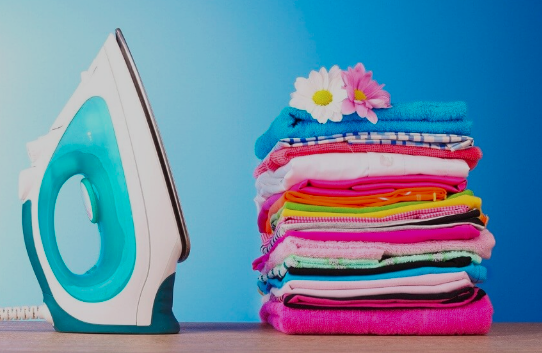Laundry Iron

Ironing is a common household chore that involves using a heated device to remove wrinkles and creases from clothing. Here’s a brief explanation of how to iron clothes and some safety tips:
II. Components and Types
A. Basic Components
- Soleplate: The flat, smooth surface that makes direct contact with the fabric.
- Temperature Control: Allows users to adjust the heat setting based on the fabric type.
- Water Tank: Present in steam irons, it holds water that can be released as steam to aid in the ironing process.
- Cord and Plug: The power cord connects the iron to the electrical outlet, and the plug is used for power supply.
B. Types of Irons
- Dry Irons: Operate without steam and are suitable for fabrics that do not require moisture during ironing.
- Steam Irons: Equipped with a water tank to generate steam, enhancing the ironing process and making it more effective.
- Travel Irons: Compact and lightweight, designed for portability during travel.
- Cordless Irons: Operate without a power cord, providing greater flexibility but requiring periodic recharging.
III. How to Use a Laundry Iron
A. Preparing the Iron
- Filling the Water Tank: For steam irons, adding water to the tank to generate steam during ironing.
- Setting the Temperature: Adjusting the temperature based on the fabric type.
B. Ironing Techniques
- Sorting Clothes: Separating clothes based on fabric type and recommended ironing temperatures.
- Ironing in Batches: Streamlining the process by ironing similar items together.
- Proper Ironing Strokes: Exploring techniques such as the flat press, steam ironing, and vertical ironing.
C. Ironing Tips and Tricks
- Using Pressing Cloths: Placing a pressing cloth between the iron and delicate fabrics to prevent damage.
- Utilizing Steam Effectively: Knowing when and how to use steam for optimal results.
- Ironing Different Fabrics: Tailoring ironing techniques to suit various fabrics, including cotton, silk, wool, and synthetic materials.
IV. Iron Maintenance
A. Cleaning the Soleplate
- Removing Residue: Addressing mineral deposits and fabric residue that can accumulate on the soleplate.
- Regular Inspection: Checking for scratches or damage that may affect the iron’s performance.
B. Descaling
- Reasons for Descaling: Understanding the importance of descaling to maintain steam generation.
- Descale Solutions: Exploring commercial descaling solutions and DIY alternatives.
C. Storage Tips
- Cooling Down Properly: Allowing the iron to cool before storing to prevent damage.
- Cord Management: Properly winding and storing the cord to avoid tangles.
V. Technological Advances
A. Smart Irons
- Temperature Sensors: Smart irons with built-in sensors that adjust the temperature based on fabric type.
- App Integration: Connectivity with mobile apps for personalized ironing settings.
B. Energy Efficiency
- Quick Heating Features: Minimizing energy consumption with rapid heating elements.
- Auto Shut-Off: Safety features that automatically turn off the iron when not in use for a specified period.
VI. Troubleshooting Common Issues
A. Lack of Steam
- Potential Causes: Identifying reasons for insufficient steam generation.
- Solutions: Steps to troubleshoot and resolve steam-related issues.
B. Sticking or Scorching
Safety Trips
- Causes: Understanding factors that can lead to sticking or scorching of fabric.
- Prevention and Remedies: Implementing preventive measures and solut
- Read the Manual: Familiarize yourself with your iron’s user manual to understand its features and safety instructions.
- Unplug when not in use: Always unplug the iron when you’re finished using it. This prevents accidents and saves energy.
- Keep away from water: Never use an iron near water to avoid the risk of electrical shock. Ensure your hands are dry when handling the iron.
- Handle with care: Be cautious when handling a hot iron. Use the handle, and avoid touching the heated plate directly.
- Store Safely: Store the iron in a safe place, away from the reach of children and pets, and ensure the cord is not damaged.
- Check for Damaged Cords: Regularly inspect the power cord for any signs of damage. If you notice any issues, replace the cord or the iron.
- Ventilation: Ensure the room is well-ventilated, especially when using the steam function. Steam can generate heat and moisture.
- Ironing in a Safe Area: Set up your ironing station in a clear and uncluttered area to prevent accidents.
Environmental Impact
A. Energy Consumption
- Energy-Efficient Models: The role of energy-efficient features in reducing the environmental impact.
- Renewable Energy Options: Exploring ways to power irons using renewable energy sources.
B. Materials and Manufacturing
- Sustainable Materials: The use of eco-friendly materials in manufacturing irons.
- Recyclability: Considering the recyclability of iron components.
Conclusion
In conclusion, the laundry iron is a fundamental household appliance that has undergone significant advancements over the years. From the basic components and types to the latest technological innovations, understanding how to use and maintain an iron is essential for efficient and safe garment care. As we continue to prioritize energy efficiency and environmental sustainability, manufacturers are exploring smart technologies and eco-friendly materials. By following proper ironing techniques, maintenance routines, and safety guidelines, users can maximize the lifespan of their irons while minimizing their environmental footprint. Whether it’s a traditional steam iron or a cutting-edge smart iron, the goal remains the same: to keep our clothes looking crisp and well-presented.




